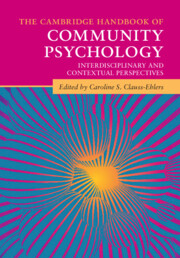Book contents
- The Cambridge Handbook of Community Psychology
- The Cambridge Handbook of Community Psychology
- Copyright page
- Dedication
- Contents
- Figures
- Tables
- Contributors
- Foreword
- Part I Foundational Concepts
- 1 Promoting Change amid Systemic Oppression
- 2 Community Psychology
- 3 Now Would Be a Great Time to Raise Your Voice
- 4 Ethics and Community Psychology
- 5 Defining Wellness across World Cultures
- Part II Research, Assessment, and Program Evaluation
- Part III Community Psychology in Action
- Part IV Where Do We Go from Here?
- Index
- References
2 - Community Psychology
Getting to Work
from Part I - Foundational Concepts
Published online by Cambridge University Press: 16 December 2021
- The Cambridge Handbook of Community Psychology
- The Cambridge Handbook of Community Psychology
- Copyright page
- Dedication
- Contents
- Figures
- Tables
- Contributors
- Foreword
- Part I Foundational Concepts
- 1 Promoting Change amid Systemic Oppression
- 2 Community Psychology
- 3 Now Would Be a Great Time to Raise Your Voice
- 4 Ethics and Community Psychology
- 5 Defining Wellness across World Cultures
- Part II Research, Assessment, and Program Evaluation
- Part III Community Psychology in Action
- Part IV Where Do We Go from Here?
- Index
- References
Summary
This chapter describes five working theories that can be useful to practicing community psychologists. They are the brain children of David McMillan in collaboration with others including J. R. Newbrough and Ray Lorion. The five theories are: 1. A four major-element, twenty-six sub-element theory of Psychological Sense of Community; 2. A four-part typology of communities building on Tönnies 1800’s two types of community, Gemeinschaft and Gesellschaft – McMillan adds two additional types, Gefolgschaft and Notschaft; 3. Community moods: McMillan proposes that emotions are contagious. He offers nine basic emotions common to humankind and proposes that these emotions can function like a virus and can be treated similarly with emotion antidotes; 4. Communities have developmental stages: McMillan builds on Erikson’s (1968) eight stages of human development and adds two other stages, conception and termination; 5. The last practical theory McMillan offers is Newbrough’s (1995) Third Position Theory. This theory creates a negotiation, mediating problem-solving strategy that can undo dichotomous gridlock.
Keywords
- Type
- Chapter
- Information
- The Cambridge Handbook of Community PsychologyInterdisciplinary and Contextual Perspectives, pp. 16 - 47Publisher: Cambridge University PressPrint publication year: 2021
References
- 1
- Cited by

